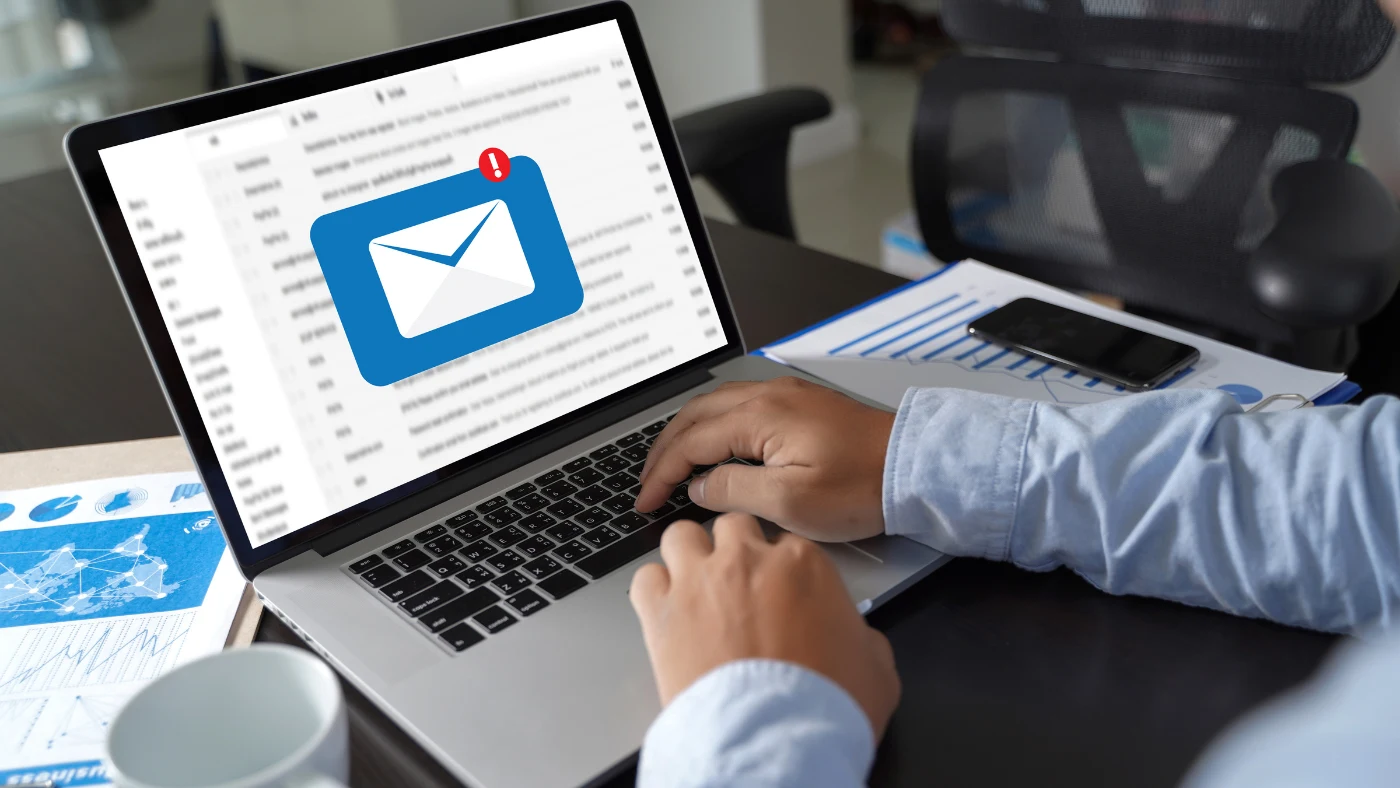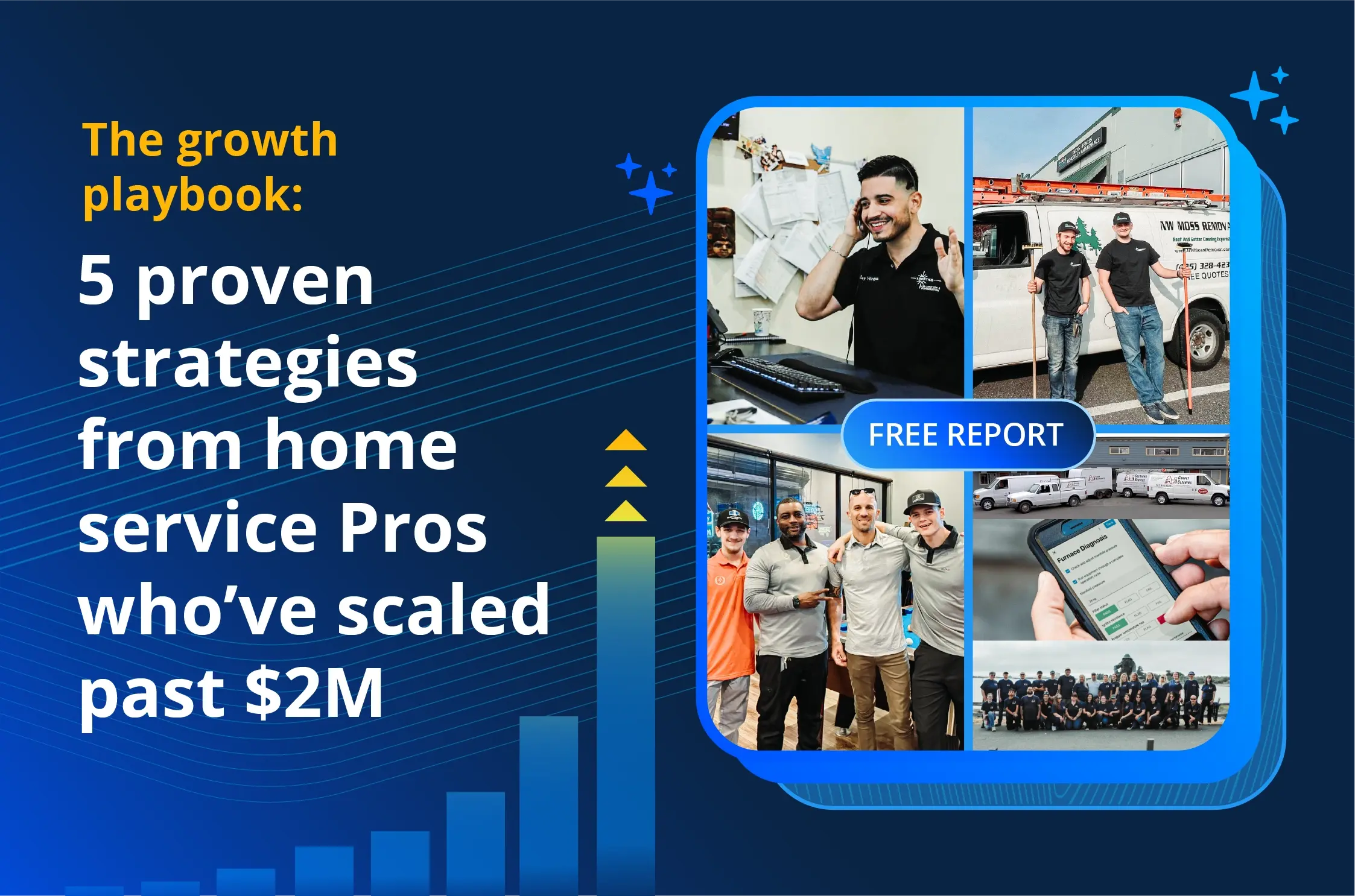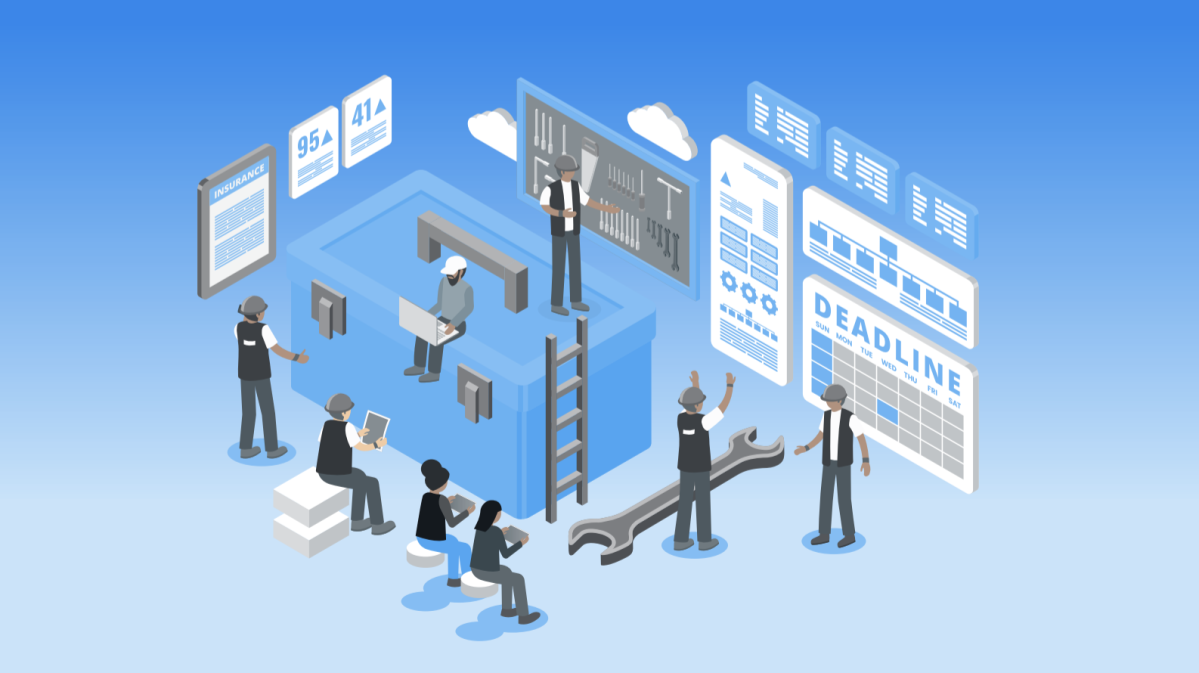Want to win more jobs with less effort?
Grow your business and send quick quotes with our home service software.

As a business owner, you want to make sure your important messages get to your intended audience. If your emails end up in spam filters, it means missed appointment reminders, unanswered customer service questions, and even lost job opportunities for new leads.
Fortunately, there are steps you can take to ensure your messages land in inboxes, not junk folders. In this article, we’ll explain what triggers spam filters, how to improve your email deliverability, and how to craft campaigns that keep you connected with past customers. When your emails reach the right people, you’re more likely to book jobs and grow your business.
What is email deliverability and why does it matter?
Before we get into spam filters, let’s talk about email deliverability. This refers to whether your email actually makes it to your customer’s inbox. You could write the perfect message, offer a great deal, and send it at the perfect time, but if it never shows up in your target audience’s inbox, it’s not doing you any good.
Unfortunately, this happens more often than you might think: over 16% of emails fail to reach the recipient’s inbox. That means one in six messages isn’t getting to the right place, often without the sender realizing it.
One major reason? Spam complaints. These occur when a recipient clicks “Report as Spam” on your email, signaling to their email provider that your message is unwanted. Just a few of these can damage your sender reputation and hurt future deliverability.
Low mailbox usage is another cause. This refers to sending emails to addresses that are rarely checked or no longer used, which can happen when you don’t clean up your email list regularly.
To stay in the clear:
- Make it your goal to achieve a 95% or higher delivery rate, which is considered excellent.
- Keep your spam complaint rate below 0.08% to maintain a good sender reputation.
- Use your email marketing platform or CRM to monitor these metrics and adjust accordingly
Why your emails are ending up in spam filters
A spam filter is a program that scans incoming emails to detect unwanted, unsolicited, or potentially harmful messages, such as those containing viruses or malicious content. These filters use specific criteria to decide whether an email is safe or suspicious, including keywords, formatting, links, and sender reputation.
Spam filters are used by internet service providers (ISPs), email platforms like Gmail and Outlook, and even company servers. Their job is to protect users from unwanted messages, but sometimes that means your legitimate emails get caught in the crossfire.
If too many people flag your messages or your content includes spam trigger words or formatting, filters can automatically mark all your emails as spam. That means:
- Your emails won’t land in the inbox.
- Customers may never see your updates or promotions.
- You risk losing out on bookings, referrals, and reviews.
That’s why understanding how to avoid spam filters is a must if you want your email marketing to drive results. Here are our top five tips to make sure your emails reach the right audience.
1. Avoid triggers in your subject line
Your subject line is the first thing both your customer and spam filters see. If it looks suspicious, your email could be flagged before it ever has a chance to be read. That means even the best message inside won’t matter if the subject line raises a red flag.
To avoid this, keep your subject lines clear, helpful, and relevant to your audience. Use natural language that makes sense for your business and avoid tactics that feel pushy or gimmicky.
Examples of good subject lines:
- Get 10% off your next HVAC tune-up—book today!
- Reminder: Your plumbing check-up is due
- Thanks for choosing us! We’d love your feedback
These work well because they’re professional, easy to understand, and useful to the reader. They also match the content of the email, which helps build trust and keeps your sender reputation strong.
What to avoid:
- LIMITED TIME OFFER!!!! 50% OFF SERVICE NOW!!!!
- FREE SERVICE!!!! CLICK HERE TO CLAIM!!!
- Open immediately for a surprise deal
These examples may get flagged for several reasons: too many capital letters or punctuation marks, vague or misleading language, or trigger words like “FREE” or “CLICK HERE.” While these might grab attention, they also signal spam filters and frustrated customers to steer clear.
Stick to a simple rule: write your subject lines like you’re talking to a real person—specific, polite, and clear.
2. Create email content that helps your customers
As a business owner, you hope that your emails will bring in more jobs, and they can when they’re written with your customer in mind. Customers appreciate content that helps them save time, avoid unnecessary repairs, or make better decisions about their home. Even quick DIY tips or seasonal reminders can go a long way in building trust and loyalty.
What you write inside your email matters just as much as your subject line. Your tone should be professional, friendly, and clear. It should never sound pushy, overly sales-focused, or like a scam. People are more likely to take action when they feel they’re getting value, not just being sold to.
Good email content: clear, friendly, and helpful
Helpful content doesn’t mean long or complicated. In fact, the best-performing emails are often short, easy to read, and focused on just one topic. You might send:
- A reminder about seasonal maintenance (like a fall HVAC check-up)
- A short how-to tip (like unclogging a drain with baking soda and vinegar)
- A customer appreciation note with a discount for repeat service
Here’s an example.
Subject Line: Don’t Forget: Your Spring AC Tune-Up is Due!
Body:
Hi [First Name],
Spring is here, which means it’s time to get your AC ready for warmer weather. A quick tune-up now can help avoid costly repairs later. We’re offering a 10% discount on all seasonal maintenance booked before May 15.
Book your service online or call us today at [Phone Number]. Thank you for choosing [Your Company Name]—we appreciate your business!
This type of email is helpful, friendly, and actionable. It sounds like it’s coming from a trusted local pro, not a spammy marketer.
If your brand voice allows it, adding a simple emoji, like a wrench, house, or calendar, can also be a fun way to catch attention. Used sparingly and appropriately, emojis can increase engagement. Just make sure the emoji fits the message and doesn’t feel out of place. Using too many emojis or adding irrelevant ones (like party hats or dollar signs) can hurt more than help.
Bad email content: spammy, pushy, or confusing
Now let’s talk about what not to do. Poorly written emails can tank your open rates, increase spam complaints, and even lead to unsubscribes.
Here are some of the biggest red flags:
- Overly aggressive sales language
- Overuse of exclamation marks and all caps
- Vague offers with no clear details
- Too many links, which look suspicious to spam filters
- No clear call to action
Here’s an example of what to avoid.
Subject Line: ACT NOW!!! UNBELIEVABLE SAVINGS ON YOUR NEXT SERVICE!!!
Body:
This is your ONLY CHANCE to SAVE BIG on your next home service!
Click here now to claim your surprise deal!
Hurry—this won’t last long!
Messages like this are pushy and generic. They don’t say what the service is, they rely on urgency without providing value, and they scream “spam.” Emails like this can damage your sender reputation and reduce customer trust.
The bottom line: Write to your customers like they’re real people, because they are. Be clear, helpful, and respectful of their time. Your emails should serve a purpose, whether that’s offering a discount, sharing a tip, or simply staying in touch.
3. Don’t email your customers without their permission
You can’t legally send marketing emails to just anyone. You need their permission first. This is where email opt-in comes in. An opt-in is when a person gives you explicit permission to send them marketing emails. This can happen when they book a service and check a box agreeing to receive updates or when they sign up through a form on your website. Always make it clear what they’re signing up for—and never pre-check the box for them.
Equally important is email opt-out. This gives people the ability to unsubscribe at any time. Every email you send should include a clear, easy-to-find unsubscribe link. Failing to do so isn’t just frustrating for your audience. It can also land you in legal trouble.
The CAN-SPAM Act is the law that governs commercial email in the U.S. It applies to any email that promotes your business or services, even if it’s just linking to a blog post on your website. The rules are clear:
- You must identify the message as an ad (or include your business contact info)
- You must include a working unsubscribe mechanism
- You can’t use deceptive subject lines or sender information
The penalties are serious. Each individual email that violates the CAN-SPAM Act can result in fines of up to $53,088. Multiply that by dozens or hundreds of emails, and noncompliance becomes a very expensive mistake.
Following the rules is all about building a relationship with your customers based on trust. Next, we’ll walk through some best practices for keeping your email list clean, legal, and effective, and what to avoid.
Best practices
If you want your emails to land in inboxes and abide by laws, start with clear permission and transparent communication. Follow these best practices to help build trust and stay compliant with the CAN-SPAM Act:
- Ask customers to opt in when they book a service. This can be in person, over the phone, or online.
- Include a checkbox on your email sign-up forms that says something like: “Yes, I want to receive updates and promotions.” Don’t pre-check the box.
- Reconfirm interest before emailing customers you haven’t heard from in a while.
- Include your business name and physical address in every marketing email—this is required under the CAN-SPAM Act.
- Add a clear unsubscribe link so recipients know how to opt out at any time.
What to avoid
To avoid deliverability issues, legal trouble, or frustrated customers, steer clear of these common mistakes:
- Don’t buy or rent email lists. These recipients haven’t agreed to hear from you, and likely don’t want to.
- Don’t email every past customer unless they’ve explicitly opted in to receive marketing messages.
- Don’t continue emailing anyone who has unsubscribed. This is a fast track to being flagged or blacklisted.
- Don’t use misleading subject lines. Make sure they accurately reflect the content of your message.
- Don’t use false or deceptive header information, such as fake names or email addresses.
- Always include a way to opt out in every marketing email you send. Make it clear and easy to use.
Get In Touch: 858-842-5746
Let us earn your trust
On average, Pros increase monthly revenue generated through Housecall Pro by 50% after their first year.
See plan options and feature breakdown on our pricing page.
4. Format your email to avoid spam filters
Even if your content is helpful and your subject line is on point, poor formatting can still land your message in the spam folder. Email providers scan not just what you say, but how you say it—down to your layout, fonts, images, and links.
That’s where Housecall Pro’s Campaigns feature comes in. It takes the guesswork out of formatting with ready-to-use templates that follow best practices for deliverability and design. You’ll save time while creating polished, mobile-friendly emails that look great and land where they’re supposed to.
If you prefer taking the time to format emails yourself, here are some tips to get you started.
Email formatting tips
Clean, professional formatting helps your emails look trustworthy—not just to your readers, but to spam filters too. If your message is hard to read, overloaded with visuals, or packed with links, it’s more likely to be flagged. Keep things simple and structured with these best practices:
- Use a professional email address tied to your business domain (example: info@yourbusiness.com), not a free personal address like HVACguys123@gmail.com.
- Write in short paragraphs to make your message easier to skim, especially on mobile.
- Limit images. A few well-placed visuals are fine, but too many images with little text can look suspicious to filters.
- Only include necessary links, such as to your booking page, review request, or contact form.
Common formatting mistakes
Even if your message is helpful, poor formatting can trigger spam filters and turn customers away. Avoid these common missteps to improve your email deliverability and overall readability:
- Don’t use tiny white text on a white background to hide extra content. This is a well-known spam tactic.
- Don’t send image-only emails. Filters can’t read images, and if there’s no supporting text, your message may be flagged.
- Avoid using too many links, especially when using strange or shortened URLs like bit.ly, as they often resemble phishing attempts.
- Don’t forget to include an unsubscribe link. Omitting it isn’t just frustrating for your reader; it can get you into legal trouble.
5. Send emails to the right audience at the right time
Sending messages that aren’t relevant to your customer is one of the fastest ways to lose their interest, or worse, get flagged as spam. If someone receives an email that doesn’t apply to them, they may delete it, ignore future messages, or mark it as spam just to keep their inbox clean. Once that happens, your future emails are far more likely to be filtered out, even for customers who do want to hear from you.
That’s why sending targeted, timely emails is key. Whether it’s a seasonal tune-up reminder, a thank you after a job, or a helpful tip based on a recent service, relevance matters. It shows you’re paying attention, and that builds trust.
Here are a few tips to help you send the right email when it matters most.
- Promote specific services to the right group. For example, if you’re offering an HVAC tune-up, send the message only to customers who’ve used your HVAC services in the past, not your plumbing or electrical clients.
- Match offers to customer history. Running a special on house cleaning? Email only those who have previously booked your cleaning services.
- Use follow-ups strategically. If someone requested an estimate but didn’t move forward, follow up with that group, not your full list.
- Segment your email list by service type or last appointment date so you can tailor future messages.
- Avoid sending generic blasts. The more targeted your message, the more likely it is to be opened and the less likely it is to end up in spam.
Key takeaways to avoid spam traps
If you want to avoid email spam filter issues, follow these five rules:
- Write subject lines that pass anti-spam filters
- Avoid aggressive language or formatting
- Only email customers who have opted in
- Use smart, professional formatting
- Segment your audience by service and timing
When you follow these best practices, your messages are more likely to land in inboxes, not junk folders.
Housecall Pro makes it easy to send targeted campaigns, manage customer retention, and follow up with automated review management tools. Ready to take control of your inbox visibility? Start crafting smarter, cleaner emails today with Housecall Pro Campaigns, and watch your next message turn into your next booking.






